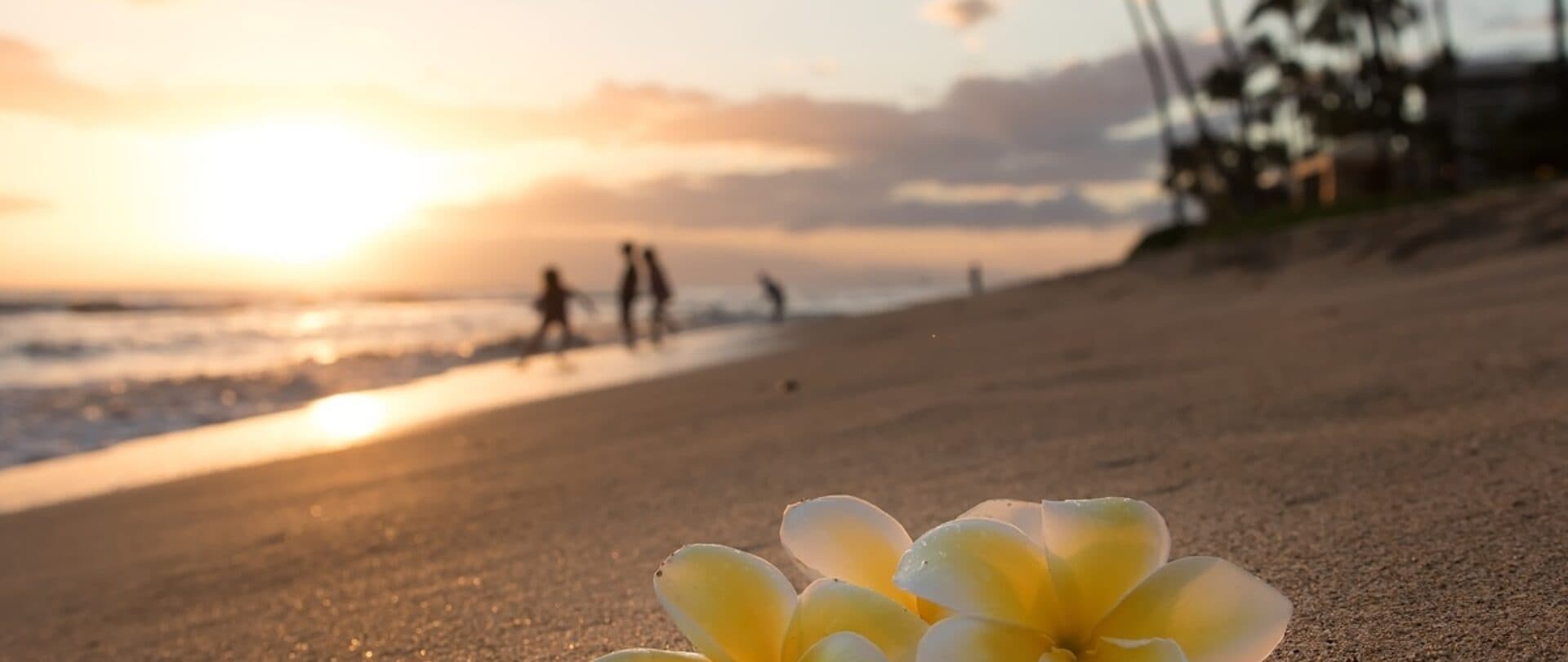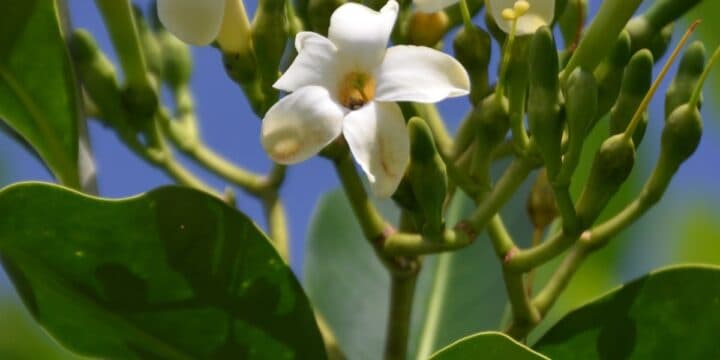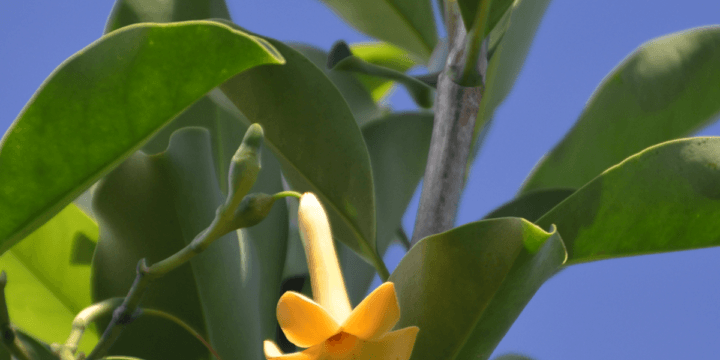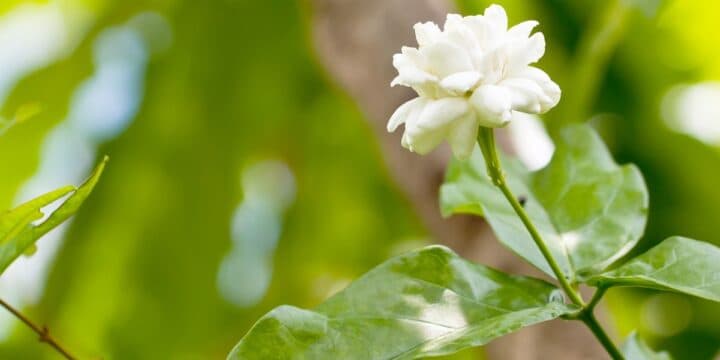
Paradise Blooms
Celebrated botanical icons that reveal deep cultural significance in Hawai'i
BY Amber Nightingale
Nestled among the lush island landscape, fragrant flowers are celebrated botanical icons that reveal deep cultural significance in ancient and contemporary Hawaiʻi. As sensory symbols with unmistakable aromatic allure, the sweet-scented blooms of melia (plumeria), pua kenikeni (perfume flower tree), pīkake (jasmine), and nānū (gardenia) create a timeless sense of place. Locals and visitors delight in these exotic gems that continue to enchant, uplift and inspire.

Melia (Plumeria)
Plumeria rubra
The precious plumeria is one of the most widely recognized flowers throughout the Hawaiian Islands. Its soft pinwheel of five petals may be seen in pearl white, pale pink, ruby red, radiant yellow and a rainbow of hues. With hundreds of cultivars found in Hawaiʻi alone, many petal shapes and sizes range from wide and narrow to elliptical, pointed, and shell-shaped. A diverse species, the melia scent is a luscious floral accord intertwined with light top notes of peachy fruit and a dash of spice. Traditionally used to weave elegant leis, this popular flower is a popular ornamental with a unique story.
Despite being a quintessential emblem of Hawaiʻi, plumeria is native to the tropical Americas, notably Brazil, Mexico and the Caribbean. Dr. William Hillebrand, an accomplished foreign physician and founder of the original Foster Botanical Gardens in Honolulu, introduced the first cultivar to Oʻahu in 1860. It quickly became a favored floral species due to the low maintenance requirements and profuse, fragrant blossoms. Planted in backyards, cemeteries and near temples, melia took precedence as one of the key bred flowers for mass lei production as tourism expanded at the end of the nineteenth century.
A classic expression of welcome and affection, the gift-giving of plumeria lei is a tradition that has endured to the present day. Initially, this universal practice of aloha remains for visitors who arrived by boat. In 2005, over fourteen million plumeria were sold exclusively for leis. Beyond these famous garlands, the flowers are also utilized in hair adornments and as a potent oil extraction for sumptuous perfumes. Often a featured print design on fashionable shirts, swimwear and other island souvenirs, this modish mainstay is held dear. Emanating beauty, grace, kindness and hospitality, the stunning melia stays true to its influential presence.
Pua kenikeni (Perfume Flower Tree)
Fagraea berteroana
Renowned for the heavenly fragrance that saturates the tiny, trumpet-shaped blooms, pua kenikeni has an unparalleled signature scent that infuses the verdant Hawaiʻi setting. The lingering aroma, described as a balanced combination of sweet citrus and melon with heavy floral undertones, indicates its common name—the perfume flower tree. Brimming with blossoms year-round, pua kenikeni has a remarkable life cycle reflected in its changing colors. Stark, ivory white flowers initially appear, maturing into pastel yellow, amber orange and finally a bronze brown. Even in an extinct withered state, the intoxicating scent is alive.
Indigenous to northern Australia and the Caroline Islands, the succulent pua kenikeni has been adored all over the Pacific for centuries. Arriving in Hawaiʻi in the late 1800s, the perfume flower tree gained acclaim as superior lei material for incoming tourists. Prized for their joyful fragrance and fragile quality, the flowers were sold for ten cents each. These treasured blooms became known as “ten-cent flowers,” or pua kenikeni translated to Hawaiian. With this historical designation, the species has prospered as a core ingredient for leis and prevalent ornamental in nurseries, beach parks, neighborhood playgrounds and scenic home gardens.
Revered as a mythical, sacred tree throughout Polynesia, pua kenikeni is also chosen for personal care and cosmetics—soaking the blossoms to enhance coconut oil and exquisite perfumes. The attractive, dainty single floret is a magnificent personal accessory tucked snugly behind the ear. Additionally prized for its quality wood, the perfume flower tree has fine-grained timber to make tools, furniture, drums and other modern handicrafts. Complementary medicine has found the inner bark effective in curing asthma and diabetes. Reminiscent of idyllic getaways, pua kenikeni exudes an everlasting essence near and far.
Pīkake (Jasmine)
Jasminum sambac
A sensual, seductive floral pleasure, pīkake (Arabian jasmine) is the classic embodiment of rapturous island romance and divine love. The honeyed flowers are cherished worldwide but are especially eminent within Hawaiʻi. Glossy, dark emerald leaves complement the waxy, cream-white blooms that open at night and close in the morning light. Layered and robust, pīkake emits a voluptuous flowery fragrance with its underlying musk base and top notes of greens and orange blossom. Native to India, where the holy plant is valued in spiritual practices, around twelve species of jasmine grow in the Aloha State.
Translating as “peacock,” pīkake received notable prestige from the royal Hawaiian Princess Kaʻiulani, who adored both the flower and bird. Her paradisical ʻĀinahau estate in Waikīkī was embellished with ambrosial jasmine, waterlily ponds, date palms and majestic peacocks. Alongside many other introduced species during this latter part of the nineteenth century, pīkake became an exclusive ornamental and constituent for lei. Rising in prominence as eager passengers appeared at Honolulu harbor, these prime flowers are abundant across the islands, creating a beautiful ambiance in everyday society.
Harvested in the morning hours when the dewy buds emanate the maximum perfume, Arabian jasmine has many applications. The pīkake lei is a highlighted accessory for Hawaiian brides and guests of honor, reserved for special occasions, such as weddings, birthdays or anniversaries. Reputed for its healing and sensory stimulating qualities, the blossoms are also used as an infusion for many tropical beauty elixirs, including essential oil, lavish lotions and (of course) opulent perfumes. Pīkake is a beloved island jewel that captivates masses of admirers with its passionate, feminine bouquet of blooms.

Nānū (Gardenia)
Gardenia brighamii
With distinctive native Hawaiian roots, the charming gardenia (nānū) carries a rare environmental legacy that links antiquity to modern times. The fragrant Gardenia genus contains over 200 species at large and features three notable endemic varieties that once thrived upon the Islands. Now endangered, these native blossoms are near extinction, but many introduced species currently flourish in Hawaiʻi. The pretty porcelain-white flowers flaunt single or double petals that range from large and flamboyant to small and solitary. Harmonizing creamy vanilla coconut with sweet floral and earth nuances, gardenia’s sultry scent traces the trends of history.
Affectionally known by many names that have prospered for millennia, native gardenia species are technically called nānū or nāʻū, while common varieties are distinguished as kiele. The long-lived nānū has a meaningful place in primeval Hawaiʻi heritage as a dye to color kapa (traditional bark cloth) from the yellow pulp of the berrylike fruits. Wood was also shaped into a critical tool called kua kuku—an anvil instrumental in the rigorous conventional cloth-making production process. An esteemed possession, the richly scented gardenia flowers were additionally strung into lei for rituals, fire-side festivities and floral tributes.
Today, this darling dry forest species is still venerated for its cultural contribution and botanic characteristics. Brilliant plant-based dyes are frequently utilized, while the gorgeous gardenia flowers are a spotlight in custom corsages, seasonal leis and decorative displays. The complex scent is also a magical ingredient for delicate eau de parfum, aromatherapeutic candles and countless luxury cosmetics. Offering a sense of warmth and renewal, the blissful gardenia brings peace, appreciation and purity of heart. From the extravagant kiele to quaint nānū, these pieces of paradise have a legendary impact that will echo for generations.




